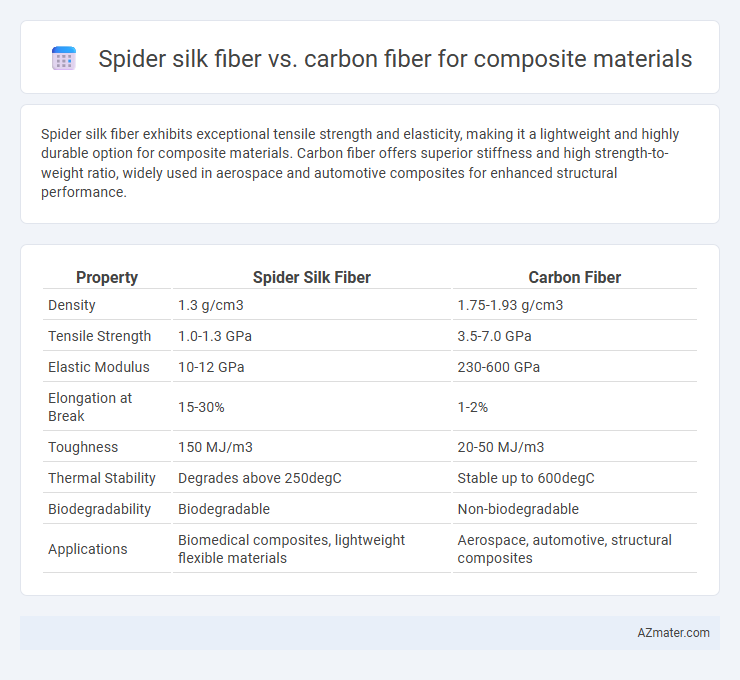Spider silk fiber exhibits exceptional tensile strength and elasticity, making it a lightweight and highly durable option for composite materials. Carbon fiber offers superior stiffness and high strength-to-weight ratio, widely used in aerospace and automotive composites for enhanced structural performance.
Table of Comparison
| Property | Spider Silk Fiber | Carbon Fiber |
|---|---|---|
| Density | 1.3 g/cm3 | 1.75-1.93 g/cm3 |
| Tensile Strength | 1.0-1.3 GPa | 3.5-7.0 GPa |
| Elastic Modulus | 10-12 GPa | 230-600 GPa |
| Elongation at Break | 15-30% | 1-2% |
| Toughness | 150 MJ/m3 | 20-50 MJ/m3 |
| Thermal Stability | Degrades above 250degC | Stable up to 600degC |
| Biodegradability | Biodegradable | Non-biodegradable |
| Applications | Biomedical composites, lightweight flexible materials | Aerospace, automotive, structural composites |
Introduction to Composite Materials
Spider silk fiber and carbon fiber are both advanced materials used in composite manufacturing, prized for their exceptional mechanical properties. Spider silk offers remarkable tensile strength, flexibility, and biodegradability, making it ideal for lightweight and sustainable composites in biomedical and textile applications. Carbon fiber composites provide superior stiffness, high strength-to-weight ratio, and excellent thermal resistance, widely utilized in aerospace, automotive, and sports equipment industries.
Overview of Spider Silk Fiber
Spider silk fiber exhibits remarkable tensile strength and elasticity, outperforming many synthetic fibers in toughness and flexibility. Its biocompatibility and lightweight nature make it an ideal candidate for advanced composite materials requiring durability and resilience. While carbon fiber excels in stiffness and thermal stability, spider silk offers superior energy absorption and biodegradability for sustainable composite applications.
Properties of Carbon Fiber
Carbon fiber exhibits exceptional tensile strength, typically around 3,500 MPa, and a low density of approximately 1.6 g/cm3, making it ideal for lightweight composite materials. Its high stiffness, with a modulus of elasticity ranging from 230 to 600 GPa, ensures superior structural rigidity and resistance to deformation under stress. Carbon fiber also offers excellent thermal stability and corrosion resistance, contributing to the durability and longevity of advanced composite applications in aerospace, automotive, and sports equipment industries.
Mechanical Strength Comparison
Spider silk fiber exhibits exceptional tensile strength and remarkable elasticity, with a tensile strength up to 1.3 GPa and elongation at break around 30%, offering superior energy absorption compared to many synthetic fibers. Carbon fiber, however, delivers higher tensile strength often exceeding 3.5 GPa and a much higher modulus of elasticity above 230 GPa, resulting in greater stiffness and load-bearing capacity within composite materials. While spider silk fibers provide lightweight flexibility and toughness, carbon fibers dominate in structural applications requiring maximum mechanical strength and rigidity.
Elasticity and Flexibility Differences
Spider silk fiber exhibits exceptional elasticity, capable of stretching up to 30% of its length without breaking, which far surpasses the limited elongation of carbon fiber, typically around 1-2%. This high flexibility allows spider silk to absorb and dissipate energy efficiently, making it ideal for applications requiring toughness and resilience. In contrast, carbon fiber's rigidity and high tensile strength offer superior stiffness but result in lower flexibility, restricting its use to structures demanding lightweight and high-strength characteristics rather than elasticity.
Weight and Density Analysis
Spider silk fiber possesses an exceptional strength-to-weight ratio with a density of approximately 1.3 g/cm3, making it significantly lighter than carbon fiber, which typically has a density around 1.75-1.95 g/cm3. This lower density allows spider silk composites to achieve comparable tensile strength while reducing overall weight, benefiting applications requiring lightweight materials. Carbon fiber, despite its higher density, offers superior stiffness and thermal stability, but spider silk's biocompatibility and flexibility provide distinct advantages in weight-sensitive, bio-integrated composite designs.
Environmental Impact and Sustainability
Spider silk fiber exhibits exceptional biodegradability and renewable sourcing through spider farming or bioengineering, significantly reducing ecological footprints compared to carbon fiber production, which relies on energy-intensive processes and non-renewable petroleum-based precursors. Carbon fiber's manufacturing emits substantial greenhouse gases and generates hazardous waste, whereas spider silk's synthesis operates at ambient temperatures with minimal environmental disturbance. The sustainability advantage of spider silk fiber lies in its lower carbon emissions, carbon neutrality potential, and superior recyclability, making it increasingly attractive for eco-friendly composite materials.
Cost and Production Challenges
Spider silk fiber offers exceptional tensile strength and flexibility but faces high production costs and scalability challenges due to complex harvesting and synthetic replication processes. Carbon fiber, while more expensive per unit than conventional materials, benefits from well-established manufacturing techniques and economies of scale, leading to more consistent availability and lower overall production complexity. The high cost of spider silk is primarily driven by bioengineering limitations, whereas carbon fiber production involves energy-intensive processes but is optimized for mass production in aerospace and automotive industries.
Application Suitability in Industry
Spider silk fiber offers exceptional tensile strength combined with lightweight flexibility, making it ideal for biomedical and wearable technology applications where biocompatibility and durability are crucial. Carbon fiber provides superior stiffness, high strength-to-weight ratio, and excellent thermal resistance, making it the preferred material in aerospace, automotive, and sports equipment industries requiring structural rigidity and impact resistance. While spider silk excels in dynamic, flexible environments, carbon fiber dominates applications demanding high load-bearing capacity and dimensional stability.
Future Prospects and Research Directions
Spider silk fiber exhibits exceptional tensile strength, elasticity, and biodegradability, making it a promising sustainable alternative for composite materials in aerospace, biomedical, and wearable technologies. Ongoing research targets genetic engineering and synthetic biology techniques to produce scalable, cost-effective spider silk with consistent mechanical properties. In contrast, carbon fiber remains dominant due to its superior stiffness and thermal resistance, but hybrid composites combining spider silk's toughness with carbon fiber's rigidity represent a cutting-edge direction for next-generation, multifunctional materials.

Infographic: Spider silk fiber vs Carbon fiber for Composite material
 azmater.com
azmater.com